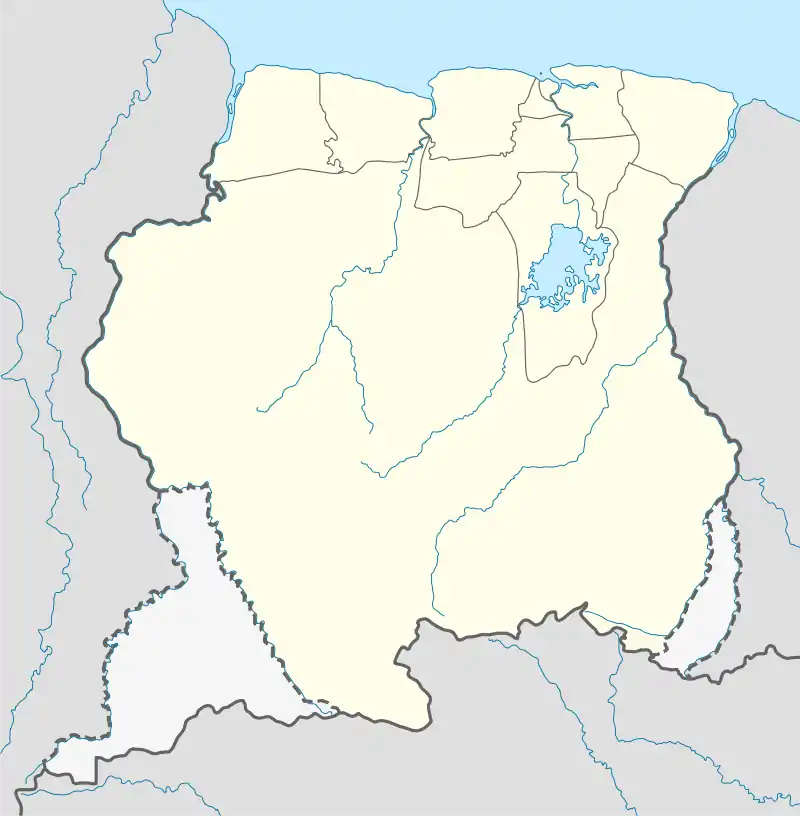Nieuw-Koffiekamp | |
|---|---|
Village | |
 Nieuw-Koffiekamp | |
| Coordinates: 5°4′31″N 55°12′44″W / 5.07528°N 55.21222°W | |
| Country | |
| District | Brokopondo District |
| Resort | Brownsweg |
| Government | |
| • Captain | Hermanus Shalwijk (2019)[1] |
| Population | |
| • Total | 300 |
| Time zone | UTC-3 (AST) |
Nieuw-Koffiekamp is a village in the resort of Brownsweg in the Brokopondo District of Suriname. It is a transmigration village built for the inhabitants of Koffiekamp which was flooded by the Brokopondo Reservoir after the construction of the Afobaka Dam.[3]
History
The transmigration village of Nieuw-Koffiekamp was founded in 1964, because the village of Koffiekamp was going to be flooded by the Brokopondo Reservoir. Koffiekamp was a federation of three settlements of the Ndyuka maroons: Maipa-ondo of the Misidjan lo (clan) founded in 1793, Baka Mbuju of the Njanfai lo, and Maria Hartmann founded Koffiekamp in 1851 as a mission of the Moravian Church.[4] The population was estimated at 500 inhabitants.[5]
Overview
Nieuw-Koffiekamp contains a school and a medical centre. It has access to the electricity grid.[6] The village is connected to the road network.[2]: 21 The number of inhabitants of the village varies greatly. The official figure in 2017 was 300, however the village council estimated the population at around 500.[2]: 20
Gold mining conflict
The economy is mainly based on gold mining. Most of the villagers used to work at the Roma Pit. In 1994 the concession was awarded to Iamgold.[7] In mid-2010, the company started to exploit the mine and removed the goldprospectors from the mine. The people were given a new area which contained significantly less gold.[8] After protests, a contract was signed with Iamgold in 2017 which permitted the villagers to remain in the Roma Pit.[9][7]
References
- ↑ "Kapitein Shalwijk: overheid moet weg asfalteren en niet Iamgold Rosebel Goldmines". Suriname Herald (in Dutch). 28 June 2019. Retrieved 15 July 2022.
- 1 2 3 "De bloeiende toekomst van Brokopondo" (PDF). Rosebel Gold Mines (in Dutch). 2017. Retrieved 15 July 2022.
- ↑ Kempen, Michiel van (2002). Een geschiedenis van de Surinaamse literatuur. Deel 2 (in Dutch). Paramaribo: Okopipi. p. 114. ISBN 9991464069. Retrieved 15 July 2022 – via Digital Library for Dutch Literature.
- ↑ "Koffiekamp in historisch perspectief". Werkgroep Caraïbische Letteren (in Dutch). Retrieved 15 July 2022.
- ↑ "Week number 64-18". Open Beelden (in Dutch). Polygoon. 1 May 1964. Retrieved 15 July 2022.
- ↑ "Regionaal Plan Brokopondo" (PDF). Planning Office Suriname (in Dutch). 2015. pp. 12, 15, 18.
- 1 2 Ine Apapoe (9 December 2020). "Maroons and Indigenous people in Suriname: the struggle for land rights". The Global Americas. Retrieved 15 July 2022.
- ↑ "Tweede transmigratie dorpelingen nieuw koffiekamp niet uitgesloten". United News.sr (in Dutch). 11 February 2016. Retrieved 15 July 2022.
- ↑ "Iamgold staat Roma Pit af aan Nieuw Koffiekamp". Starnieuws (in Dutch). 14 November 2017. Retrieved 15 July 2022.